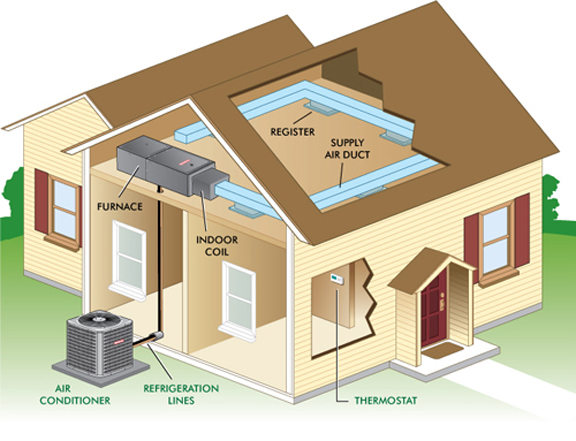
Image Credit: AHRI
UPDATED on March 2, 2017 with information on the Dettson furnace rated at 15,000 Btu/h.
Many different appliances can be used to heat a house, including boilers, water heaters, heat pumps, and wood stoves. However, most homes in the U.S. are heated by a forced-air furnace.
These devices are connected to ducts that deliver heated air to registers throughout the house. Different types of furnaces are manufactured to burn a variety of fuels, including natural gas, propane, oil, and firewood. The most common furnace fuel in the U.S. is natural gas.
In Europe, where furnaces are almost unheard of, most homes are heated by a boiler that distributes heat through hot-water pipes. Unlike Europeans, however, most Americans insist on central air conditioning in their homes. It’s easier to provide whole-house air-conditioning in a home with a duct system. Once you have a duct system for cooling, it’s cheaper to install a furnace for winter heating than to install a boiler with a separate distribution system.
Even though the smallest available furnaces are often oversized for a high-performance home — a problem I addressed in a 2009 article, Heating a Tight, Well-Insulated House — furnaces still have virtues that are hard to ignore. They are inexpensive, widely available, and easily serviced by local HVAC contractors. For many North American homes, they are a logical way to supply space heat.
[Author’s note: Since this article was written, a Canadian manufacturer has begun selling a gas furnace rated at 15,000 Btu/h. For more information, see Finally, a Right-Sized Furnace.]
Defining AFUE
When it comes to fuel efficiency, residential furnaces in the U.S. are divided into two main categories: so-called “medium-efficiency” furnaces and “high-efficiency” furnaces.
Furnace efficiency is usually calculated using a laboratory procedure that measures an appliance’s “annual fuel utilization efficiency,” or…
Weekly Newsletter
Get building science and energy efficiency advice, plus special offers, in your inbox.

This article is only available to GBA Prime Members
Sign up for a free trial and get instant access to this article as well as GBA’s complete library of premium articles and construction details.
Start Free TrialAlready a member? Log in





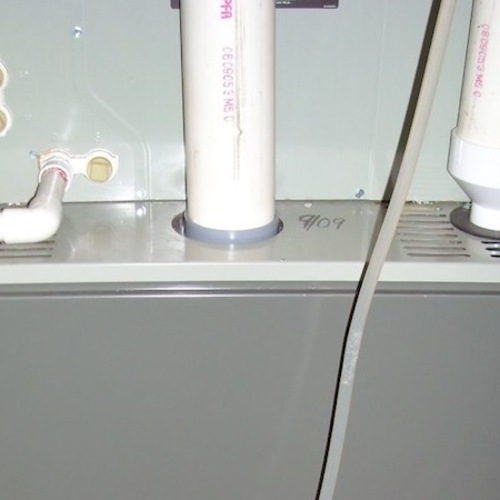
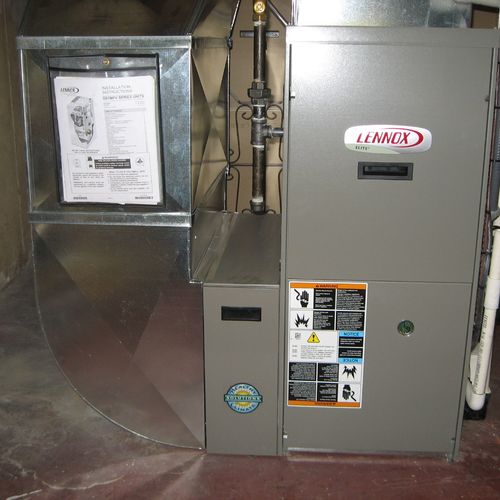
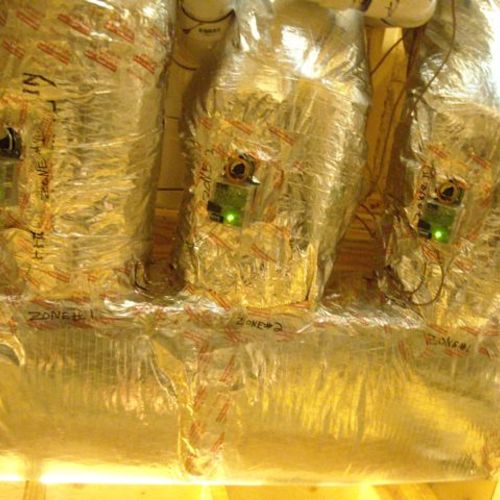
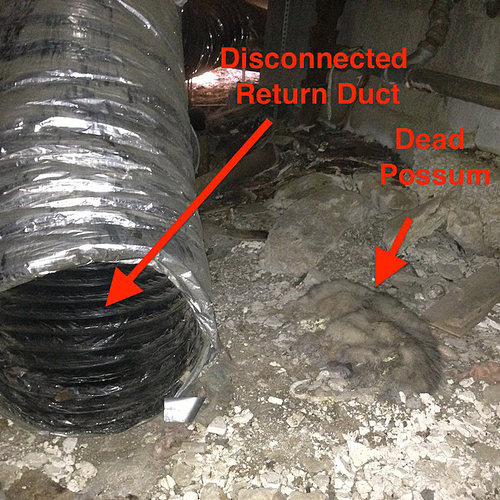






14 Comments
Condensing Oil Furnaces technically exist
Great article as usual, Martin.
I remember seeing a condensing oil furnace at AHR Expo a couple of years ago. While I've never seen one 'in the wild' (and I wonder how much cleaning they require) you can find them.
http://www.adamsmanufacturing.com/world.html
Clicking around the web a bit more, one can find forum discussions about the need for proper setup, frequent cleaning, and possibly even special fuel for these units.
All in all, a good heat pump probably makes as much or more sense. I was just standing next to a Carrier multistage unit yesterday in 9 degree temperatures, it was running along just fine. When I last did the math on a heat pump, it was less expensive to run than a propane furnace. (9 HSPF, $0.13/kWh; 95% AFUE, $2/gal)
Response to Douglas Horgan
Douglas,
Thanks very much for the feedback and correction. I have edited my article to reflect the information you provided on oil-fired condensing furnaces.
Supply and return ducts?
Martin, you state that " If you are building a tight house with thick insulation and high-quality windows, however, it’s possible to install supply registers on interior walls."
Fair enough, but wouldn't you still have to locate the return air ducts near exterior walls, which would negate the savings? What's the best strategy, low supply and high return or vice-versa?
Response to Kevin Dickson
Kevin,
Traditionally, supply registers are installed low in heating-dominated climates, and are installed high in cooling-dominated climates. Studies have shown that either high returns or low returns can work well with either type of supply system.
In a tight, well insulated house, the location of the supply registers isn't as critical as it is in an old, leaky house. Even in a heating-dominated climate, supply registers that are located near the top of an interior wall work well, as long as the registers or diffusers are chosen to have a good "throw."
Again, assuming that you have supply registers with a good throw installed high on interior walls, return grilles can also be located near the interior of the house, with no performance penalties.
Choosing the right supply registers is an art unto itself, deserving of a dedicated article.
I'm a small remodeling
I'm a small remodeling contractor. HVAC has been my weakest area. This article explains a lot.
This is a fantastic blog.
Response to Steve Gordon
Steve,
Thanks for the feedback. I'm glad that GBA is proving useful.
If I appear unresponsive...
I will be on vacation from January 25 through February 1. So if anyone posts new questions, and wonders why I'm not answering promptly... now you know.
I'll try to address unanswered questions on February 2 or 3.
Mini splits are in....
Mini splits are in.... worrying about ducts... is out.
Just Getting into the Energy Auditing field
I've been working for a mid size home performance / energy efficiency company for about 5 months. This is a great article and explains many of the problems I have noticed when repairing faulty duct work (especially things like running ducts through I-joists with sheet metal). Thank you for the great article!
Minisplit VS Conventional HVAC
My question has to do with Marc Rosenbaum recent Q&A blog on minisplits, an answer he gave below. Seems the issue can be having to leave room doors open compromising mommy and daddy’s privacy, etc, and whole house sizing(BTU’s through walls, etc) he presented some calculations on I appreciate but would not want to reply on. Manufacturing data seem unreliable too. I think if each room cannot be temperature controlled doors shut (which is one of the big advantage/selling points to potential clients aside from lower operating cost, from a builders stand point, all is lost. Others like “tricking the thermostat with heat from xmas light bulbs or you cell phone ” he suggest to set the min temp , those sort of tactics won’t sell. When it comes to comfort people rather pay the price for a proven system. So what is being suggested in the last paragraph, a hybrid forced/single zone mini air ducted that moves air from hot to cold room with doors shut, or ground fans he suggest? If so have we just lost the benefits of no ducts, associated duct problems, and installation cost? I noticed some companies offering more and more air handlers so maybe technology is moving quick here and this is a better alternative to the convention HVAC?
When your heating and cooling loads in a net-zero home are already smaller than the capacity of anything but a single wall-mount ductless minisplit, how do you balance correct sizing with adequate distribution?
Answer 3 — Leigha’s question in Comment #17 is a variation of the first question in a climate that will need cooling as well as heating. The house sounds like a single-story. With the bedrooms to the north in this very well insulated passive solar house, I’m assuming that they don’t have a ton of glazing, which in this case drives heat gains from the sun, as well as heat loss. So I might be comfortable using just a single unit in the main space if the occupants understood that the bedrooms will be cooler than the main space in winter and warmer in summer, and if the rooms met my 1,000 BTU/hr criterion mentioned above.
Having said that, the system you mentioned that incorporates a wall cassette for the main space, and a ducted unit for the bedrooms would be a step up in occupant satisfaction for many people, because the bedrooms are now able to have their own setpoint. A ducted unit with the temperature sensor built into the air handler (the stock setup) averages the return temperature from the bedrooms to decide how much heating or cooling to provide. You also have the opportunity to incorporate some good filtration in that system.
Here’s another approach: do the whole house as a single-zone ducted system. With a strongly passive solar design, the whole-house ducted system can serve to redistribute air from the warmer side of the house to the bedrooms.
Whole house single zone in tight house doesn't work
We built our tight home this last year and have a gas fired hydronic hot air system supplemented with solar thermal. We were told a single zone would work fine. The house is two stories in the front with our home offices and a guest room upstairs, an open plan living area below and a one story master suite wing in the back. The doors to all the rooms are usually open. The system, a NUair Enerboss, has an integrated HRV with separate intake ducting. The thermostat is located in the hall between the living area and the master suite. This winter we discovered to our dismay that the main living area was considerably cooler than the thermostat and that upstairs was uncomfortably warmer (80 degrees with a thermostat of 72). Also when we use the wood stove downstairs the master suite becomes uncomfortably cold and the upstairs temperature cools down a bit. We just had the HVAC firm completely block the trunk line to second floor to test if mechanical zoning would improve the situation which it did. The upstairs is now within 2 degrees of the thermostat with outside temps in the single digits. Essentially the second floor doesn't require any heat. We assume the opposite will be true in the summer when the second floor will need the most cooling. Our plan is to have mechanical dampers and thermostats controlling the second floor and the master separately from the living area.
In retrospect I think we would have been better off with 3 minisplits but we got the solar thermal system and gas furnace at no cost by participating in a NYSERDA program to test the effectiveness of adding solar thermal to gas fired hot water systems.
Our advice is that if you go with an air system in a tight house you should design the system for zoning unless the house is a very simple single floor open plan home.
Response to Terry Lee (Comment #10)
Terry,
You have raised several issues in your discussion of minisplits versus conventional ducted forced-air systems. It's fair to say that there are advantages and disadvantages to both approaches.
If a customer wants consistent temperatures from room to room, even when the doors are closed, then a well designed, well installed ducted forced-air system probably makes more sense than a single ductless minisplit in the living room.
That said, few forced-air systems are well designed or well installed. Poorly designed and leaky duct systems are responsible for tremendous quantities of wasted energy. Anyone interested in achieving very low energy bills should consider whether a ductless minisplit or a ducted minisplit might satisfy their needs.
Response to Elizabeth Kormos (Comment #11)
Elizabeth,
Thanks for sharing your experiences. You're right that it is difficult to maintain even temperatures if a two-story house is heated and cooled with a single-zone forced-air HVAC system. I agree with your conclusion that a few ductless minisplits would have worked better for you than the system that was installed.
For more information on this issue, see Keeping Cool in a Two-Story House, including the comments posted below the article.
Condensing Oil Furnaces & 2 Stage Oil Furnaces
Martin,
I really enjoyed this article. For areas in the New England states where oil is the primary fuel for heating, ThermoPride branded furnaces (specifically the OHC95 & OH6 2-Stage) could be the best options for homeowners looking to conserve energy. Even in a new home, where energy efficient building practices are on the top of the list.
Log in or become a member to post a comment.
Sign up Log in